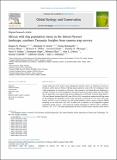| dc.contributor.author | Parsais, Singira | |
| dc.contributor.author | Searle, Charlotte | |
| dc.contributor.author | Strampelli, Paolo | |
| dc.contributor.author | Moyo, Francis | |
| dc.contributor.author | Giliba, Richard | |
| dc.contributor.author | Haule, Leonard | |
| dc.contributor.author | Olesyapa, Kandey | |
| dc.contributor.author | Salum, Nasri | |
| dc.contributor.author | Hape, Germanus | |
| dc.contributor.author | Elisa, Manase | |
| dc.contributor.author | Lobora, Alex | |
| dc.contributor.author | Cotterill, Alayne | |
| dc.contributor.author | Doody, Kathryn | |
| dc.contributor.author | Dickman, Amy | |
| dc.date.accessioned | 2025-05-20T11:37:04Z | |
| dc.date.available | 2025-05-20T11:37:04Z | |
| dc.date.issued | 2025-05-03 | |
| dc.identifier.uri | https://doi.org/10.1016/j.gecco.2025.e03621 | |
| dc.identifier.uri | https://dspace.nm-aist.ac.tz/handle/20.500.12479/3156 | |
| dc.description | This research article was published by Global Ecology and Conservation , Volume 60, August 2025 | en_US |
| dc.description.abstract | Despite being one of the world’s most endangered carnivore, there is a deficiency of recent information on the status of African wild dog (Lycaon pictus) in some of the few landscapes where viable populations are thought to still occur. One example is the Selous-Nyerere landscape in southern Tanzania, a critical stronghold for the species that has not been studied since the 1990s. We use data from seven camera trap surveys deployed over 4674 km2 in Selous Game Reserve (GR) and Nyerere National Park (NP) from 2020 to 2022 to provide an update on wild dog status in the landscape. We identified a total of 222 wild dogs, of which 38 % were male, 38 % were female, and 24 % were of unknown sex. We applied spatially explicit capture-recapture (SECR) modelling to the data from 2565 km2 of Selous GR to estimate an over-dispersion adjusted population density of 2.14 ± 0.45 adult and yearling wild dogs per 100 km2 (95 % confidence interval: 1.42 – 3.21). This study demonstrates the ways in which camera trap data can be used to improve our understanding of wild dog populations in data-limited settings, but also highlights some limitations of this data type for the species. Our findings suggest that the Selous-Niassa ecosystem is one of the most important remaining populations of wild dogs in Africa. Although this study did not directly investigate mortality, we recommend long-term monitoring and a number of conservation actions to tackle the species’ apparent threats in the landscape, and help secure this stronghold into the future. | en_US |
| dc.language.iso | en | en_US |
| dc.publisher | Elsevier | en_US |
| dc.subject | African wild dog | en_US |
| dc.subject | Lycaon pictus | en_US |
| dc.subject | Population status | en_US |
| dc.subject | Spatially explicit capture-recapture | en_US |
| dc.subject | SECR | en_US |
| dc.subject | Selous-Nyerere landscape | en_US |
| dc.subject | Tanzania | en_US |
| dc.title | African wild dog population status in the Selous-Nyerere landscape, southern Tanzania: Insights from camera trap surveys | en_US |
| dc.type | Article | en_US |

